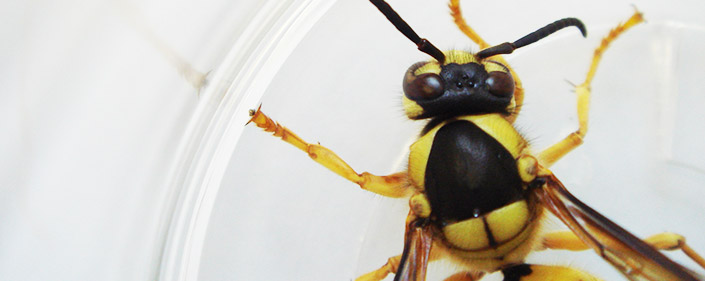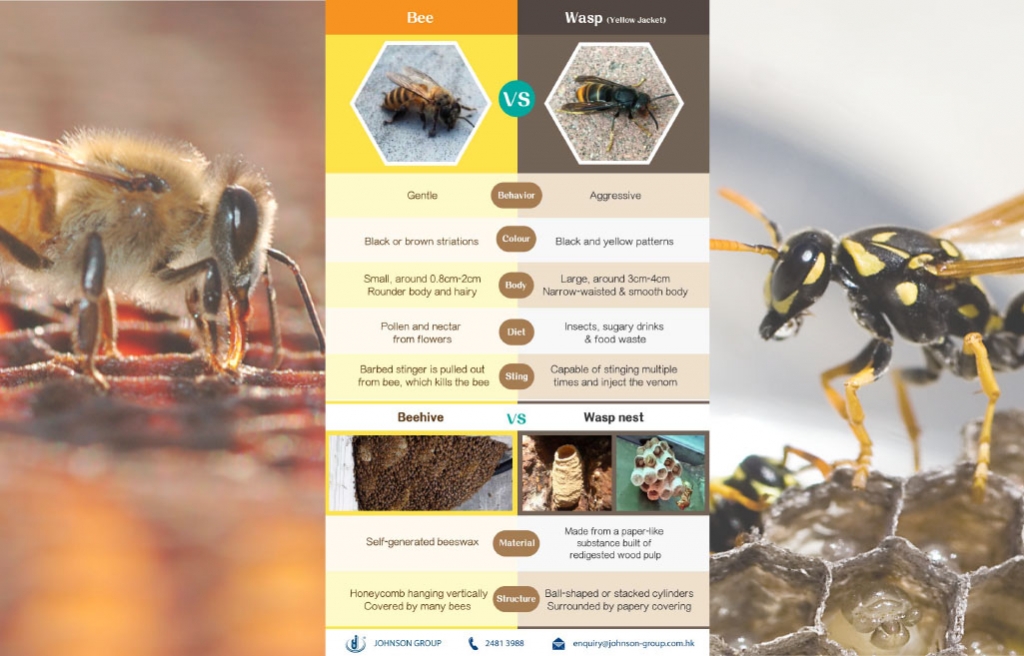- Bees Are Not The Same As Wasps. Bees Pose No Harm to Us Unless We Disturb Them!
Wasps
Most of these are black-and-yellow, some are black-and-white (such as the bald-faced hornet, Dolichovespula maculata), while others may have the abdomen background color red instead of black.
Wasps belong to insect order Hymenoptera which is also shared by bees. Quite different from bees, which only sting once, wasps are stinging insects that are able to withdraw their stings for use again and again.
A wasp has wasp-waist caused by a deep constriction between the thorax and abdomen. They have two pairs of membranous wings and have yellow and black markings on their bodies.
They develop with complete metamorphosis: egg, larva, pupa and adult. The adult wasps are of three forms: male, female and worker. The males and females are reproductive with the females (or queens) founding the nests and laying eggs. The workers are sterile females. Each female and worker wasp is armed with a sting used for defence against predators. The male is unarmed.
A new nest is started by a single female (queen) in the spring. After several generations and under favourable conditions, new males and females are produced in the summer or autumn. The fertilized females then hibernate over the winter and become active in the spring.
The Differences between bee and wasp
Life Cycle
Nests of both yellow-jacket and paper wasps typically are begun in spring by a single queen who overwinters and becomes active when the weather warms. She emerges in late winter/early spring to feed and start a new nest. From spring to midsummer nests are in the growth phase, and the larvae require large amounts of protein.
Workers forage mainly for protein at this time (usually in the form of other insects) and for some sugars. By late summer, however, the colonies grow more slowly or cease growth and require large amounts of sugar to maintain the queen and workers. Normally, yellow-jacket and paper wasp colonies only live one season. However, some yellow-jacket colonies survive for several years and become quite large.
Nests
The wasps build a nest of paper made from fibers scraped from wood mixed with saliva. It is built as multiple tiers of vertical cells, similar to nests of paper wasps, but enclosed by a paper envelope around the outside that usually contains a single entrance hole.
If the rodent hole is not spacious enough, yellow-jackets will increase the size by moistening the soil and digging.Similar behavior inside a house sometimes leads to a wet patch that develops into a hole in a wall or ceiling.
Aerial-nesting yellowjackets, Dolichovespula arenaria and D. maculata, build paper nests that are attached to the eaves of a building or are hanging from the limb of a tree.The entrance is normally a hole at the bottom of the nest.
These aerial nesters do not become scavengers at the end of the season, but they are extremely defensive when their nests are disturbed. Defending D. arenaria sometimes bite and/or sting, simultaneously.
Wasp stingers have no barbs and can be used repeatedly, especially when the wasp gets inside clothing. As with any stinging incident, it is best to leave the area of the nest site as quickly as possible if wasps start stinging.
Distribution
They may fly 2-3 km to search for food. Large aggregation of wasps is usually caused by food attraction.
Sanitation Practices
Once food is discovered by wasps, they will continue to hunt around that location long after the source has been removed.
Most social wasps provide an extremely beneficial service by eliminating large numbers of other pest insects through predation and should be protected and encouraged to nest in areas of little human or animal activity.
The best way to prevent unpleasant encounters with social wasps is to avoid them. If you know where they are, try not to go near their nesting places.
Wasps can become very defensive when their nest is disturbed. Be on the lookout for nests when outdoors. Wasps that are flying directly in and out of a single location are probably flying to and from their nest.



